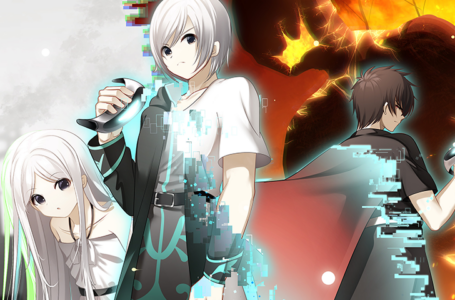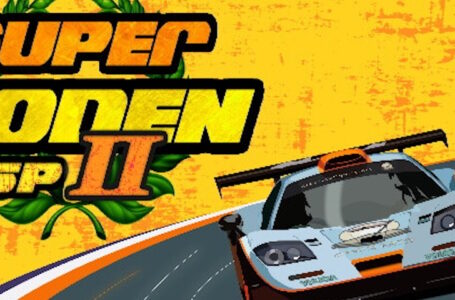We need to talk about Steam and visual novels
Not for the first time, a Japanese game has suffered Steam’s banhammer, seemingly on the grounds that it includes characters dressed in school uniforms. The difference this time around is that it’s a pretty high-profile case: Chaos;Head Noah from Spike Chunsoft, part of the Science Adventure series that also includes titles like Steins;Gate and Robotics;Notes.
Let’s just say up-front that Chaos;Head Noah is not an “adult” game in the sexual sense; there is no explicit sexual content. However, it is, like the other Science Adventure titles, most definitely a mature game that features discussion of trauma and psychological issues as well as violent scenes.
Spike Chunsoft hasn’t been specific about the exact reason the game can’t be released on Steam in their statement, only that they felt the changes Steam requested to the game’s content would “not allow the game to be released to their standards”. In all likelihood, the combination of “school uniform” and “violent scenes” is the cause, but as with most situations like this, we will probably never know the full truth.
That doesn’t mean we shouldn’t talk about this, however. And I think we’re long overdue a very in-depth discussion about this matter in general. So let’s do just that.
Note: This article features explicit sexual imagery and discussion of explicit themes.
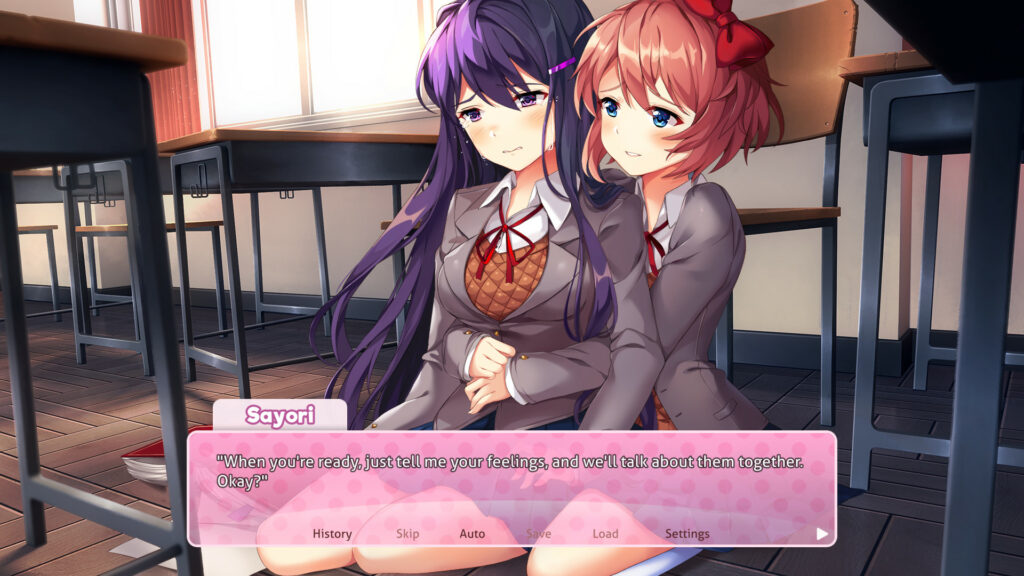
Steam’s inconsistency
The first thing that it’s important to acknowledge is that Steam is woefully inconsistent when it comes to this sort of thing. For example, if we run with the theory that Chaos;Head Noah’s inability to release on Steam is due to the combination of school uniforms and violence, how does one explain the existence of Doki Doki Literature Club? There’s one major difference between the two games, which is that Chaos;Head Noah is Japanese and Doki Doki Literature Club, despite its Japanese-inspired title and aesthetic, is western-developed. But surely that can’t be the cause, right?
Of course, Valve is never going to admit to what essentially amounts to xenophobia in its content policies, but looking at the other situations like this from the last few years, it’s hard not to see a bit of a pattern.
The completely all-ages Esperanto-themed educational visual novel The Expression Amrilato from Japanese dev SukeraSparo found itself having trouble with a Steam release a while back, for example. Evenicle 2 from legendary Japanese eroge producer Alicesoft found itself completely unable to release on Steam despite its predecessor being seemingly absolutely A-OK.
The all-ages port of Japanese visual novel Bokuten: Why I Became an Angel got booted off Steam for accidentally still including an adults-only image in its game files, despite this not being accessible in-game. And Sting’s fantastic dungeon crawler Dungeon Travelers 2 seemingly got nixed from Steam release before the PC port had even been announced by anyone.
This wouldn’t be a problem if Steam had clear content policies, but it doesn’t.
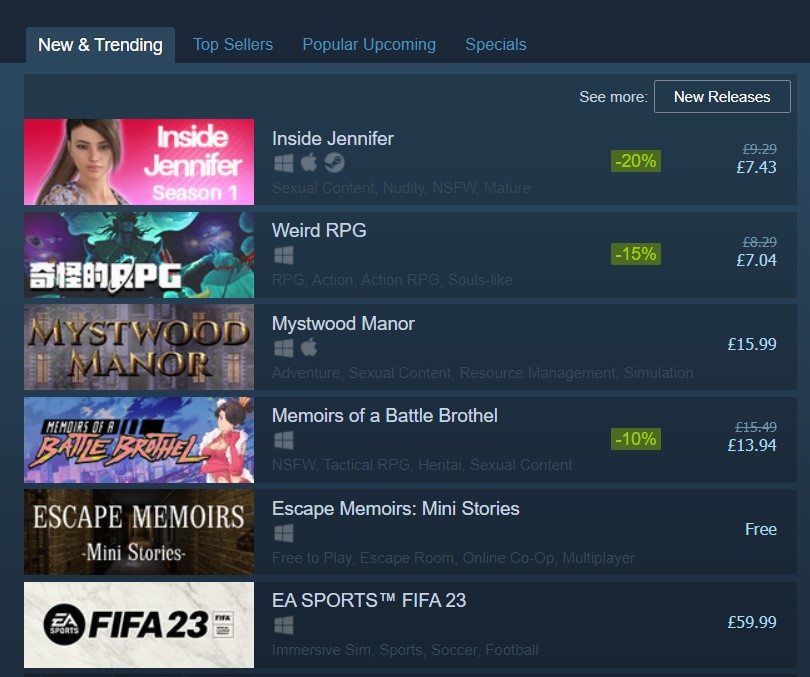
The above image is Steam’s “New and Trending” list for October 3, 2022, as seen by an account that allows adult content to be visible. Top entry is “Inside Jennifer”, an explicit western-developed visual novel that, the moment you click on its product page, immediately hits you with video of full-on uncensored penetrative sex. A few entries below that, we have “Memoirs of a Battle Brothel”, whose product page features pixel art sexual scenes with explicit narration, as well as a more conventional anime-style piece of character art featuring a character masturbating using a whip.
Then, of course, there’s this — perhaps the benchmark for how far Steam has fallen since it stopped actively curating things other than harmless Japanese visual novels:
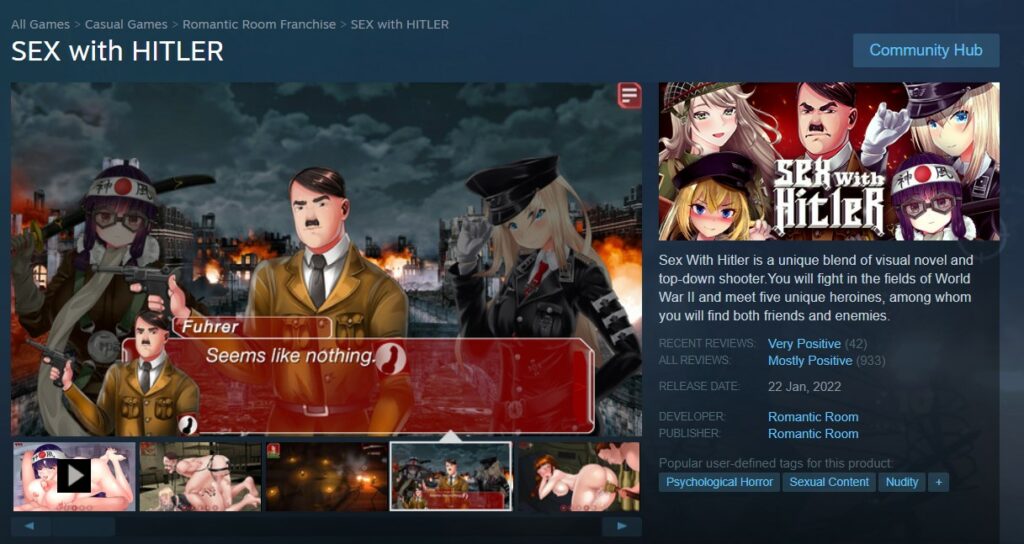
Given that something like Sex With Hitler can exist on Steam while Chaos;Head Noah can’t, it’s very difficult not to see some sort of anti-Japanese bias going on. Whether this is the cause of individual reviewers working for Valve or a company-wide policy is impossible to say with how secretive Valve is about the way it works internally — it’s honestly surprising we haven’t seen a whistleblower of some sort come forward at this point — but that just means we have to go on the evidence we’re given. And that evidence isn’t encouraging.
Does Steam matter?
Here’s the big question. Does Steam actually matter? Does it matter for a visual novel if it doesn’t get a release on Steam, if its fans know they can pick it up somewhere else — either on another hardware platform (such as Nintendo Switch, where Chaos;Head Noah has encountered no problems releasing) or another digital storefront?
Most developers, publishers and localisers argue that yes, Steam is important. As the “default” digital storefront for the vast majority of PC gamers, so far as many potential audience members are concerned, if it’s not on Steam, it doesn’t exist. That means that if something doesn’t release on Steam, it’s missing out on sales from people who are already inclined to pick up the game as well as being discovered by people who might be new to visual novels, stumble across it and think “oh, that looks interesting, I’ll give it a go”.
I think, at this point, we need to start looking at ways to move past this mindset, because it’s clearly not working. Steam is already a suboptimal platform for visual novels because of its inconsistent content policies and the sheer volume of stuff that is released on there every day. And established visual novel fans are already accustomed to using alternative storefronts to get uncensored 18+ releases. At this point it feels like the western visual novel market is large enough that putting together some sort of alternative is both practical and desirable — a “Steam of visual novels”, if you will, featuring both all-ages and 18+ releases.
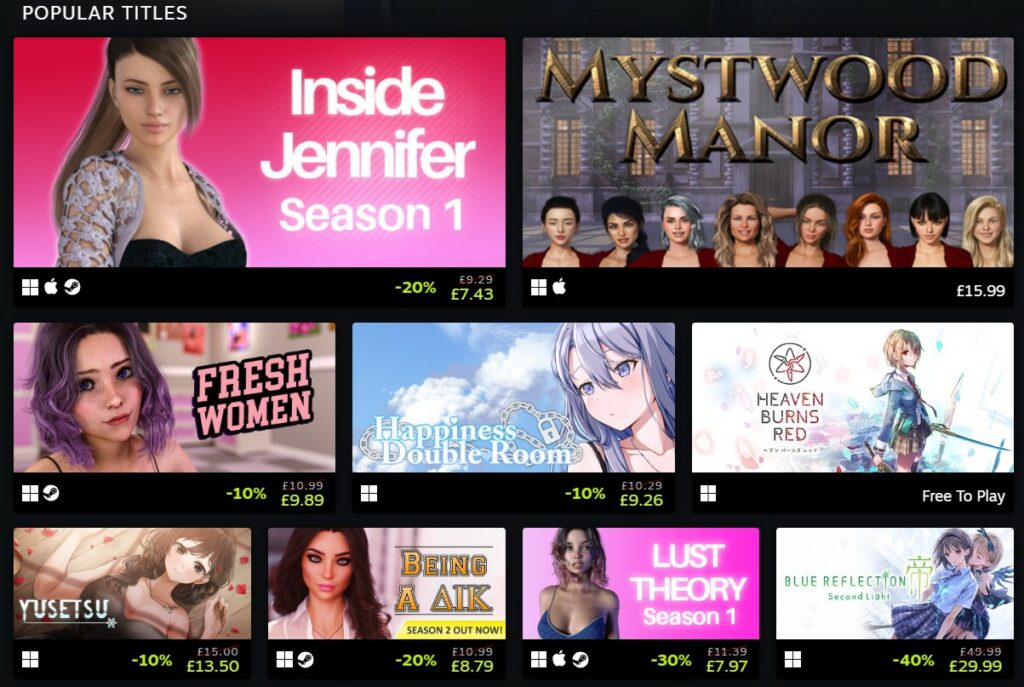
There are challenges to this, of course. Firstly, you’ve got to get established Steam addicts off Steam. PC gamers enjoy having all their games in one place, which is Steam’s main selling point — though there are alternative pieces of software out there now that allow you to bring together all your games from disparate storefronts into a single library. LaunchBox is a good example that also has the added benefit of being a great emulation front-end, and GOG.com’s Galaxy client has been built from the ground-up to support multiple libraries.
Secondly, you need to consider how discovery works — and how this can perhaps be done differently. Right now, heavy reliance is placed on being featured on Steam in some way, be that through the New and Trending tab, the front page or personalised recommendations. It’s all algorithm-based — and as anyone who has attempted to get their voice heard on any sort of social media in the last ten years will know, getting yourself heard above people who are deliberately and underhandedly manipulating said algorithm is very difficult.
Instead, alternative avenues need to be pursued. Social media. YouTube ads. Better information on the companies’ own websites. Even magazine adverts — yes, they still exist; companies such as NIS America, PQube and Idea Factory regularly take out full-page adverts in publications such as Retro Gamer, for example. And all those things need to get people accustomed to the idea of looking somewhere specific for their visual novel needs — somewhere that isn’t Steam.
The Steam of visual novels
So what might a “Steam of visual novels” look like? Well, for starters it would need to have a clear and inclusive content policy that excludes outright illegal material, but is otherwise permissive of titles that can be legally commercially released in various territories around the world.
However, and here’s an important point we’ll return to in a moment, it would need to show a friendly, all-ages storefront by default, with 18+ adult content either being opt-in, or in a completely separate, age-gated section with some form of proper, reliable but unobtrusive verification in place. The experience one gets when arriving at “The Steam of visual novels” should be a welcoming, warm and inclusive one, not one that places adult content front and centre. But, as I say, we’ll come back to that in a moment.
The store should be clearly categorised. At the very least, there should be distinct sections for bishoujo games, otome games and BL titles because while there is crossover between those markets, they also have their distinct fanbases. There could also be a distinct section for those games that blend strong visual novel elements with more traditional “gameplay”, for those seeking such experiences.
Ideally, you would be able to search by tag or subject matter, with these tags being reliable and curated rather than running the risk of turning into stupid community memes like Steam’s “Psychological horror” tag.
The use of tags would allow for some sort of recommendation engine based on a user’s previous purchases, and would also allow users to express a desire not to be recommended particular types of material. For example, someone who enjoys 18+ visual novels but does not wish to see controversial material such as NTR, loli or violence should be able to express those preferences without works involving them simply being excluded from the store for everyone.
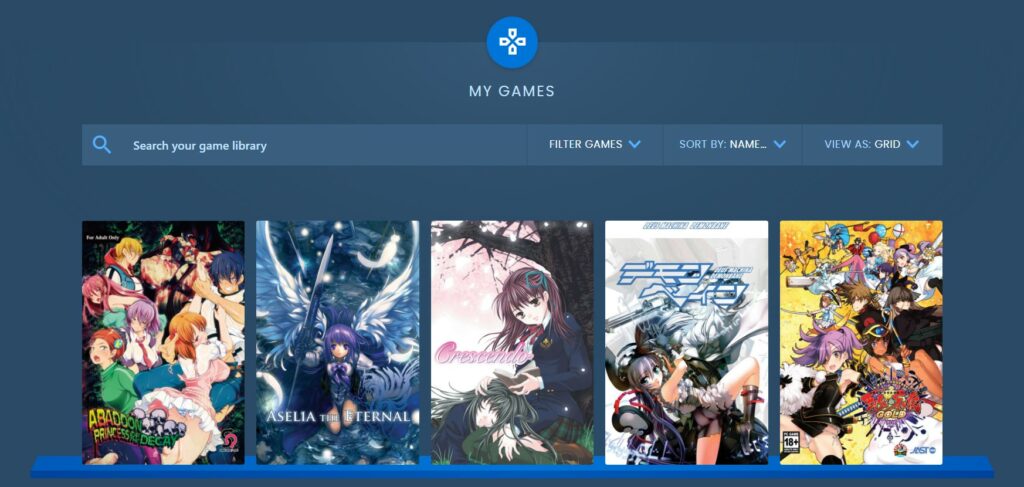
The store would feature a client that allows users to build up an attractive “library” of software, displayed either as a list or cover art. Said library should be fully searchable and filterable, and each individual title should, where applicable, offer not only the game, but also supplementary material such as digital versions of manuals or other printed material that came with physical releases. Crucially, though, the library should not enforce DRM, and should allow users to download a standalone installer to back up their purchases to their own media as desired. Essentially, it should incorporate many of the features of GOG Galaxy, but exclusively for visual novels.
The client should be lightweight and simple rather than cluttering itself up with social features and digital collectibles; the latter would discourage asset flips intended to make people buy them purely for achievements and/or cards. At the very minimum, the client should offer a simple overlay that allows players to easily take screenshots and keep them filed alongside their games in the library.
While we’re dreaming, a “retro” section featuring integration with The Asenheim Project for web-based play of classic titles that don’t run properly on modern operating systems would be the icing on the cake.
The porn problem
I mentioned above that any sort of “Steam of visual novels” needs to take great care that it doesn’t place adult content front and centre. This is not because adult content is in any way something to be ashamed of — but rather that it having too much prominence can cause some undesirable connections to be made by people outside of the core audience.
How many people have you spoken to about visual novels, only for them to assume that you mean “porn games”? How many people have you attempted to convince to play a visual novel, only for them to refuse to on the grounds that it had adult content (even, in some cases, if it actually doesn’t)? How many times have you attempted to discuss a favourite visual novel, but found yourself immediately defensive about sexual content?
As great as it is that the visual novel medium embraces adult content and sexuality, it remains a fact that some people don’t want to engage with that side of things and find it actively offputting. So there are some things that we need to do.
Firstly, we need to try and detach the concept of “visual novel” from the concept of “porn game”. There are already great strides being made in this direction with the growth in the medium on the western side of the fence — and particularly its crossover with the “wholesome gaming” space — but on the Japanese side of things, many people still make a connection between “anime-style visual novel” and “sex game”. The only way to fix this is to talk. Actively. Unashamedly.
Outlets like ourselves are an important part of this, but you are important too. Play a visual novel that you like, and talk about it. And do so for some other reason than “man, this character has thicc thighs” or “uooohhh loli pantsu” because that’s not really helping anyone other than people already inclined to respond to that sort of thing — positively or negatively.
There’s absolutely no shame whatsoever in finding a character attractive and fascinating purely because of their personality, or a relatable story that they have to tell — so highlight those things when talking about a game in a public space if you want more people to know about it. This isn’t to say you can’t talk about the sexual content at all — just pick an appropriate time and place to bring it up.
The second issue is to do with marketing. Here’s what a Google search for the website Nutaku looks like:

Nutaku has previously looked like they might want to take steps towards providing that “Steam of visual novels” concept we talked about earlier — they even have their own client now, for example. But with a Google listing like that, certain people are going to “nope” right the fuck out of there without even taking a look at the library on offer.
Likewise, here’s a product page on MangaGamer for the recently released Renai X Royale:
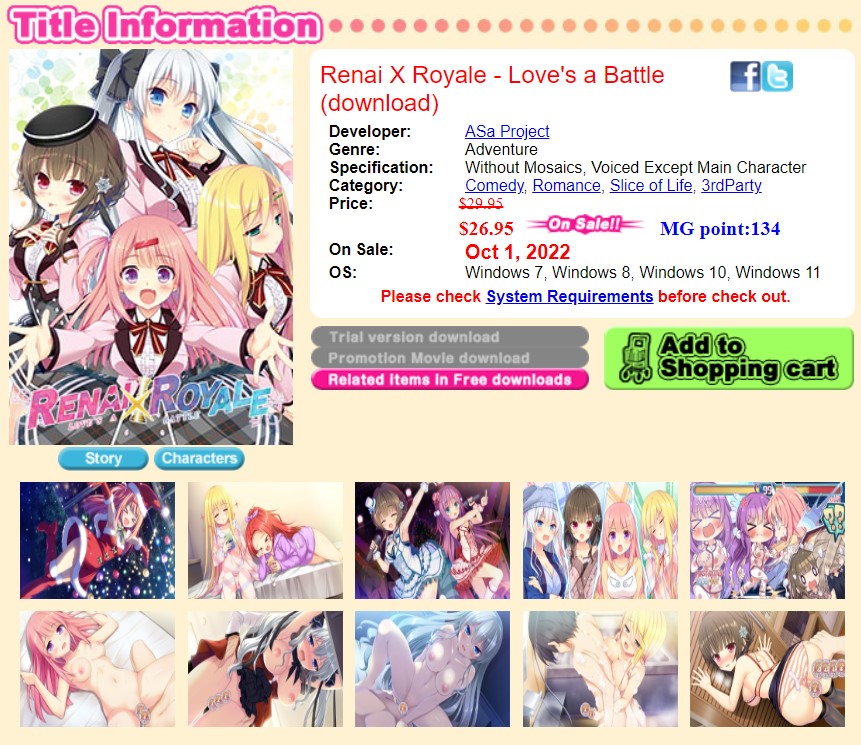
Top row of screenshots? Aww, cute. Bottom row? PORN PORN PORN PORN PORN. Now, yes, one might argue that it’s unrealistic not to acknowledge the fact that an eroge features erotic content — but again, I suspect there are people out there who might have been interested in exploring Renai X Royale for its cute side being deterred from trying it out by how up-front that porn angle is.
And not necessarily because they’re averse to 18+ scenes, either; it just sort of feels a bit disrespectful to games that place an emphasis on story and characterisation for them to get boiled down to “here’s all the scenes of the heroines getting nailed”. And this isn’t even considering the “spoiler” angle.
So, bearing in mind our “Steam of visual novels” idea from earlier, here’s some things that we could do.
Firstly, as previously noted, the Steam of visual novels should be all-ages by default. It should open up and show a variety of high-quality, non-erotic content that won’t frighten off newcomers. The adults-only section should be easily accessible for those who want to go straight to it, however.
The Steam of visual novels should also list both all-ages and adults-only versions of games where they exist, and there should be the means to switch between the two versions when choosing which one to buy. Product pages should also be required to have a breakdown of the differences between the two versions — and ideally there should be an “upgrade” path from all-ages to 18+ for those who change their mind after starting to play. For those who own both versions of a game, they should be able to install and launch either one independently rather than having to “patch” one.
Product pages for both all-ages and adults-only versions of game should include filters similar to those that vndb has on its tag and screenshot sections. Potential spoilers and adult content should be excluded from both by default, even on the adults-only page, but “opting in” to see that information or those images should be just a single click away, and there should probably be an option available for “always show these by default”.
To put it another way, when you open the Steam of visual novels for the first time, it should provide an experience that you’d be happy to have open on your screen in front of your mum. “Porn” should not be front and centre, but it should be readily available for those who want it. The experience should be inclusive to everyone, not “if you want to come in here, you’re going to have to deal with anime girls getting boffed from every direction”. But, crucially, if you want to see anime girls getting boffed from every direction, they’re there for you.
How likely is this to happen?
We’ve had this discussion many times before, and, as previously noted, so many publishers and developers are extremely hesitant to leave Steam behind because the size of the potential market it offers simply cannot be ignored at this point. But the situation with Chaos;Head Noah, by far the highest-profile game to have suffered beneath Steam’s inexplicable banhammer, makes it clear that something has got to change at this point. And for those changes to happen, it’s going to need cooperation from everyone.
Publishers, developers and localisers are going to need to work together to find a common solution for distributing their wares. And audiences are going to need to commit to supporting that solution — even if, in the short term, it might mean things are a bit pricier than on Steam. Long-term, it could absolutely work — but it will be a challenge to get off the ground. And that’s why there’s a severe risk of things just continuing on as they are, with a lot of people moaning and nothing actually getting done.
Alternatively, Valve could just issue some clear guidelines about what is and isn’t allowed on their platform, and then just stick to them. But at this point I feel like our alternative solution, as many variables as it has and as labour-intensive as it will be to get underway, is more likely to actually happen!
In the meantime…
A fan campaign has been launched to get Valve to reverse their decision on Chaos;Head Noah, and while change.org petitions rarely go anywhere productive, it is at least an opportunity to try and make your voice heard. There is also some precedent for online pressure groups to get things done; one of the best examples remains “Operation Rainfall”, which played a leading role in bringing the original Xenoblade Chronicles, The Last Story and Pandora’s Tower to the west in the twilight years of the Wii.
To that end, fan movement “Operation Hidden Hand” have decided to focus their efforts on contacting Valve en masse and attempting to get Chaos;Head Noah released on Steam. If you’d like to get involved with their campaign, you can find their Twitter account here and their change.org petition here.
It should hopefully go without saying that if you do intend to participate in any sort of emailing campaign, we encourage you to be respectful yet assertive in your communications. No-one’s going to respond to an angry weeb hurling obscenities at them, but a well-considered, positive argument with plenty of evidence to back it up may well be a different matter. Good luck!
Devs, pubs, localisers: we want to hear from you
Have you worked as a developer, publisher or localiser on visual novels that have been affected by Valve’s inconsistent content policies? We’d love to hear about your experiences, anonymously or otherwise. Please use the contact form below to get in touch.
You can use a pseudonym and there is no requirement to include personally identifying information, but note that submitting a message through this form indicates that you consent to your comments potentially being used in a future article on the subject.
Join The Discussion
Rice Digital Discord
Rice Digital Twitter
Rice Digital Facebook
Or write us a letter for the Rice Digital Friday Letters Page by clicking here!
Disclosure: Some links in this article may be affiliate links, which means we may earn a small commission if you make a purchase after clicking on them. This is at no additional cost to you and helps support Rice Digital!
- Letter from the Editor: passing the torch - June 30, 2023
- Super Woden GP 2 is looking promising - June 30, 2023
- Inti Creates is making a 32 bit-style Love Live action platformer - June 26, 2023





